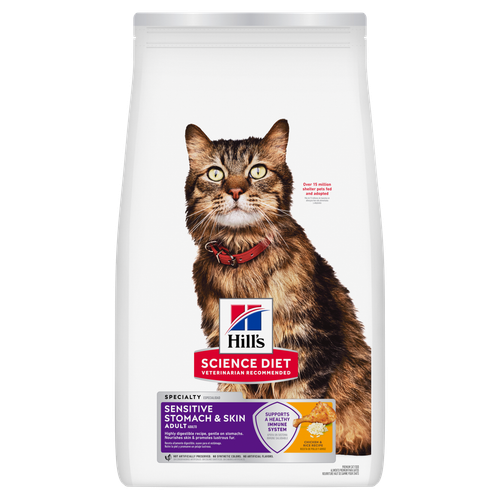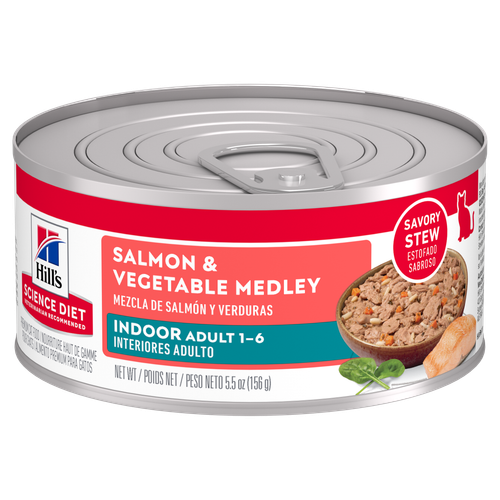
-
Find the right food for your petTake this quiz to see which food may be the best for your furry friend.Find the right food for your petTake this quiz to see which food may be the best for your furry friend.Featured products
 Adult Large Breed Chicken & Barley Recipe Dog Food
Adult Large Breed Chicken & Barley Recipe Dog FoodSupports healthy joints, lean muscle, and beautiful coat for large breed dogs
Shop Now Hill's Science Diet Adult Chicken & Beef Entrée Dog Food
Hill's Science Diet Adult Chicken & Beef Entrée Dog FoodChicken & Beef Entrée in a delicious loaf with complete & balanced nutrition to help keep adult dogs active and healthy
Shop Now Adult Chicken & Barley Recipe Dog Food
Adult Chicken & Barley Recipe Dog FoodSupports lean muscle and beautiful coat for adult dogs
Shop NowFeatured products Hill's Science Diet Adult Sensitive Stomach & Skin Chicken & Rice Recipe Cat Food
Hill's Science Diet Adult Sensitive Stomach & Skin Chicken & Rice Recipe Cat FoodScience-backed nutrition tailored for skin and digestive health, packed with clinically proven, immune system supporting antioxidants.
Shop Now Adult 7+ Senior Vitality Chicken & Vegetable Stew Cat Food
Adult 7+ Senior Vitality Chicken & Vegetable Stew Cat FoodImproves Everyday Ability to Get Up & Go
Shop Now Adult Chicken Recipe Cat Food
Adult Chicken Recipe Cat FoodSupports lean muscle and beautiful fur for adult cats
Shop Now -
Dog
- Dog Tips & Articles
-
Health Category
- Weight
- Food & Environmental Sensitivities
- Urinary
- Digestive
- Joint
- Kidney
-
Life Stage
- Puppy Nutrition
- Adult Nutrition
- Senior Nutrition
Cat- Cat Tips & Articles
-
Health Category
- Weight
- Skin & Food Sensitivities
- Urinary
- Digestive
- Kidney
-
Life Stage
- Kitten Nutrition
- Adult Nutrition
Featured articles How to Properly Mix Wet & Dry Pet Foods
How to Properly Mix Wet & Dry Pet FoodsAn Orange cat eating from a bowl filled with mixed food
Read More What Is Littermate Syndrome? Pet Adoption Guide
What Is Littermate Syndrome? Pet Adoption GuideLearn more about littermate syndrome in dogs and cats and how to successfully navigate adoption and early socialization processes.
Read More The Science Behind Our Love for Pets
The Science Behind Our Love for PetsLearn the scientific reasons why we have such strong connections with our pets, and what science says about the love between humans and our furry friends.
Read More -


A cat's just not a cat without their distinctive feature: the whiskers. But why do cats have whiskers, anyway? Can you trim cat whiskers?
Believe it or not: Whiskers play an important role in your cat's ability to sense the world around them. Here's what you need to know about your feline friend's unique feature.
What Are Cat Whiskers?
Although they look like antennae and have a radar-like function, cat whiskers are highly sensitive hairs made of keratin, a protein also found in their claw sheaths. The whisker hairs, also called vibrissae or tactile hair, are embedded deeper in the cat's skin than their fur, and each follicle (where the whisker connects to your cat's body) has many sensitive nerve endings.
A cat's facial whiskers are the most prominent of all animal whiskers and they're very much a part of a cat's distinct look. Cats typically have 24 whiskers on their muzzle, evenly distributed with twelve on each side. Generally speaking, the length of their whiskers is proportionate to the width of their body, notes Animal Planet. However, if your cat puts on a few extra pounds, their whiskers do not grow longer to match up. Cat whiskers also grow on their chins, above their eyes and on the backs of their front legs. According to the Guinness World Records, the longest cat whiskers on record belong to Missi, a Maine Coon whose whiskers measure 7.5 inches!
Why Do Cats Have Whiskers?
Whiskers aren't just hair. They're honed tools connected to one of your cat's five senses: touch. Whiskers help a cat with spatial determination ("Can I fit through that narrow doorway?"), expressing their feelings and locating their prey. All cat whiskers work together as "touch organs" for your kitty, helping them maneuver around furniture or trap that catnip toy they've been stalking.

Whiskers allow your cat to "see" in the dark because the whiskers pick up on the airflow around them, allowing them to detect their intended object down to its exact location and dimensions. That's a pretty impressive superpower.
As a form of cat communication, whiskers can convey that your furry friend is not happy. As Cornell University's College of Veterinary Medicine describes, cat whiskers that are "flattened or pressed downward onto the face" are a sign of aggression.


Tasty Tips
What Is Cat Whisker Fatigue?
Feline whisker fatigue is a condition that occurs when a cat's whiskers become sensitive from repetitive actions like brushing up against their food and water bowls, explains Cat Health, resulting in tenderness and irritation. Signs of whisker fatigue include pawing at their cat food instead of putting their head in the dish, and exhibiting signs of stress during mealtime. If you suspect your cat has whisker fatigue, Cat Health recommends switching out your cat's food and water bowls to ones that are shallow, allowing more room for whiskers to move about freely. Check in with your veterinarian to see if there may be other underlying issues, especially if you notice frequent whisker loss.
Can You Trim Cat Whiskers?
Much like a haircut, it doesn't hurt a cat if you accidentally cut off the tip of a whisker while trimming their claws, or if your cat needs their whiskers cut back before a medical procedure. "The whiskers will grow back in a couple of months, and the actual cutting of them isn't painful because they don't have nerve endings in [the whiskers themselves]," Dr. Leonie Richards, associate professor and head vet of general practice at the University of Melbourne, tells Science Daily.
However, you should never intentionally cut or pull out a cat's whiskers. Always stay clear of their whisker follicles, which are extremely sensitive to pain. Cutting a cat's whiskers reduces their ability to function, which leads to disorientation, dizziness and fear because they lose their sense of direction and cannot maneuver their body around.
Don't be alarmed if you find a stray whisker from time to time, usually near a cat's feeding area. Cat whiskers shed as they get older, but another one will grow in its place. As your cat advances into their golden years, their whiskers may turn gray. It's all a normal part of the aging process.
Left to their own devices, your cat's whiskers work to keep your furry friend operating at their peak level of health and wellness.


Christine O'Brien is a writer, mom, and long-time cat parent whose two Russian Blues rule the house. Her work also appears in Care.com, What to Expect, and Fit Pregnancy, where she writes about pets, pregnancy, and family life. Find and follow her on Instagram and Twitter @brovelliobrien.
Related products

Science-backed nutrition tailored for skin and digestive health, packed with clinically proven, immune system supporting antioxidants.

Precisely balanced nutrition for indoor cats with the delicious taste of salmon & vegetable medley

Improves Everyday Ability to Get Up & Go

Supports lean muscle and beautiful fur for adult cats
Related articles

When you adopt a cat, you don't just gain a best friend; you also save her life. Here's why getting a cat from a local animal shelter makes so much sense.

Discover how to train your cat, starting with very basic first steps that both reward good behavior and discourage the bad.

Discover which cat toys games your feline friend might like, and how they are great sources of exercise. Explore our library of articles to learn more.

Learn how to litter train a kitten with this guide to potty training, including when to start litter training kittens and troubleshooting tips.

Put your cat on a diet without them knowing
Our low calorie formula helps you control your cat's weight. It's packed with high-quality protein for building lean muscles, and made with purposeful ingredients for a flavorful, nutritious meal. Clinically proven antioxidants, Vitamin C+E, help promote a healthy immune system.
Put your cat on a diet without them knowing
Our low calorie formula helps you control your cat's weight. It's packed with high-quality protein for building lean muscles, and made with purposeful ingredients for a flavorful, nutritious meal. Clinically proven antioxidants, Vitamin C+E, help promote a healthy immune system.

